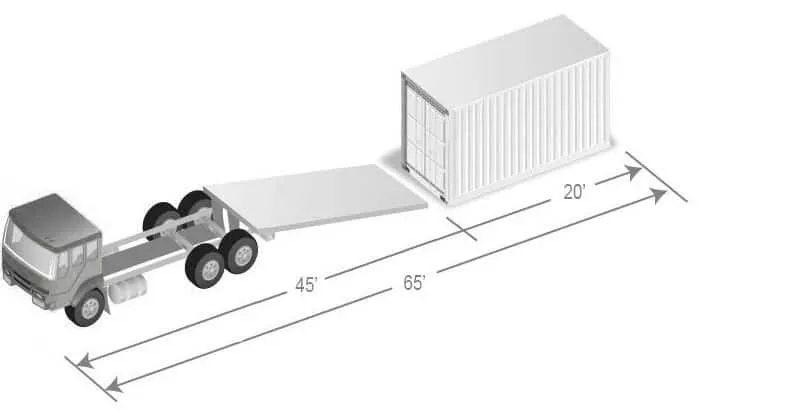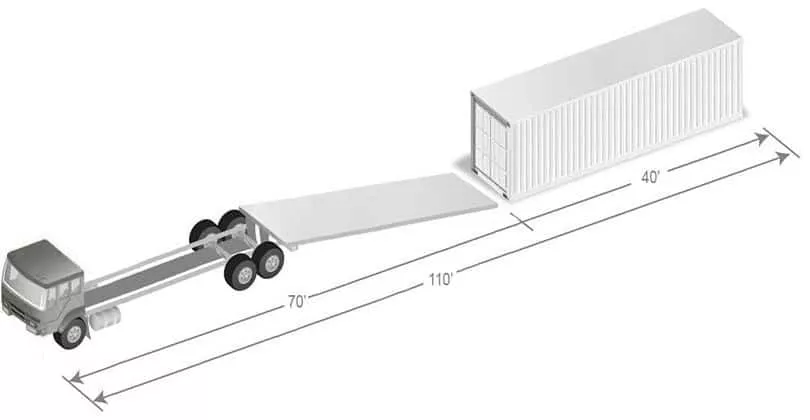Shipping container delivery
How we transport a container is one of the most frequent queries we receive from clients.
We have several possibilities to determine the best techniques to guarantee a seamless and effective delivery experience because we carry shipping containers all across the country EVERY SINGLE DAY.
The container delivery procedure should take 15 to 20 minutes, given that the site is clear and that sufficient space is available for delivery. Please keep in mind that extra waiting time delays, a lack of room, incorrect container loading instructions, etc., will all add up to more time, which may lead to more expenses.
SITE ACCESS
Shipping containers are delivered on tilt and load trailers which are able to back into position and slowly drop the container down into the desired location. In order for a successful delivery, the site will need to meet two main criteria: space to maneuver and straight-line clearance.
Space to maneuver on-site includes being able to enter the property easily and have adequate space for the container placement. Entering a site can be problematic for trailers delivering 40’ containers. These trailers are 53′ long and require free and clear access to the property in order to deliver without assistance. They are unable to make sharp 90-degree turns from two-lane streets or similar into narrow entrances.
Once the trailer has entered the property, the site must have sufficient width, height and most importantly, length requirements to guarantee a smooth delivery. As the container will be sitting on a deck that is 12’W, they will require at least 1’ ft on either side to back into and out of position for a total width requirement of 14’W. Once in position, the driver will tilt the bed of the container upwards and at its highest point, the container can reach a height of 18’H. Finally, the span required to drop the container is referred to as straight-line clearance.
WIDTH REQUIRED FOR TRAILER: MINIMUM 14′
HEIGHT REQUIRED FOR TRAILER: MINIMUM 18′
STRAIGHT-LINE CLEARANCE
Once the delivery truck has entered the property, the following straight-line clearance is required on-site to deliver the containers into their desired location

20FT CONTAINER DELIVERY
The truck will need at least 65 feet of straight line clearance to carry a 20′ shipping container in order for the delivery procedure to go properly. As seen here, this space need takes into account the length of the truck deck, the container itself, and the vehicle itself.

40FT CONTAINER DELIVERY
The same process is used to deliver a 40’ shipping container. However, as you can imagine, the truck is much larger and requires a much larger clearance area. For the delivery of a 40’ sea can to run smoothly, the truck will require a minimum of 110 feet of straight line clearance as shown below.
ACCESSIBILITY & GROUND CONDITIONS
A successful delivery also takes into account the weight of the trailer and empty container. Given that the overall weight may surpass 50,000 pounds, we advise delivery on stable terrain that can sustain the weight and keep the trailer from sinking. This is particularly important when there is grass or when the vehicle needs to cross an unpaved field or other comparable terrain to get to a desired spot.
When the delivery drivers arrive, they will evaluate the site’s accessibility and ground conditions to see if they can make the scheduled delivery. If the conditions are not fulfilled, they can either offer to drop off at an other place or deny delivery, in which case delivery fees will be applied for the failed journey.
Do not hesitate to contact us if you have any concerns concerning any of the delivery issues listed above. We would be pleased to assist you in evaluating your site more thoroughly.
LEVEL GROUND
One of the most important factors we can recommend is to ensure that the containers doors are sitting on a relatively level ground surface on delivery. This prevents the frame from bending and twisting which can lead to eventual issues opening and closing the doors over time. For this reason, we recommend any of the following surfaces for your storage container: concrete pad, pavement, crushed gravel base, railroad ties, concrete blocks, wood, etc.
We also strongly recommend that the container does not sit directly in grass or surfaces where water can pool to extend the longevity of your sea container. Excess moisture can rot the undercarriage of the container which can affect the structural integrity of the flooring.
OBSTRUCTIONS
Obstructions can cause delays or completely halt the delivery process. Obstructions that can prevent a delivery include but are not limited to: low hanging tree branches, powerlines, heavy traffic, , parked cars, etc. Ensuring the desired location is free of any of these elements will avoid unnecessary delays which can results in additional delivery charges.
DOOR LOADING DIRECTION
Most standard shipping containers have doors on one end. So the placement of the original container doors on the truck is very important to consider for its final placement at your location.
Keeping in mind that the truck backs into position to tilt the container onto the ground, loading the truck with the container doors facing the rear will result in the doors being placed in their final position first.
If the container doors are loaded to face the cab of the truck, the doors will be the last part of the container to be placed onto the ground. While the sales team can certainly help explain the process in more detail, it is the customer who better understands the final placement on site and must provide us appropriate door loading directions for delivery.
COLD WEATHER ISSUES
winters might affect commercial and industrial container rental clients when it comes time to schedule container pickup at the conclusion of the lease period. There are a few things to consider in order to prevent extra delivery fees when phoning to arrange a container pick-up during the winter. First things first, the container has to be clean of snow on the roof. The driver may decline to pick up if this requirement is not fulfilled, since they run the danger of facing heavy fines for driving while driving in the snow and ice. This is a mandate from the Ministry of Transportation. The container is frequently frozen in the tilt bed and the ground.
